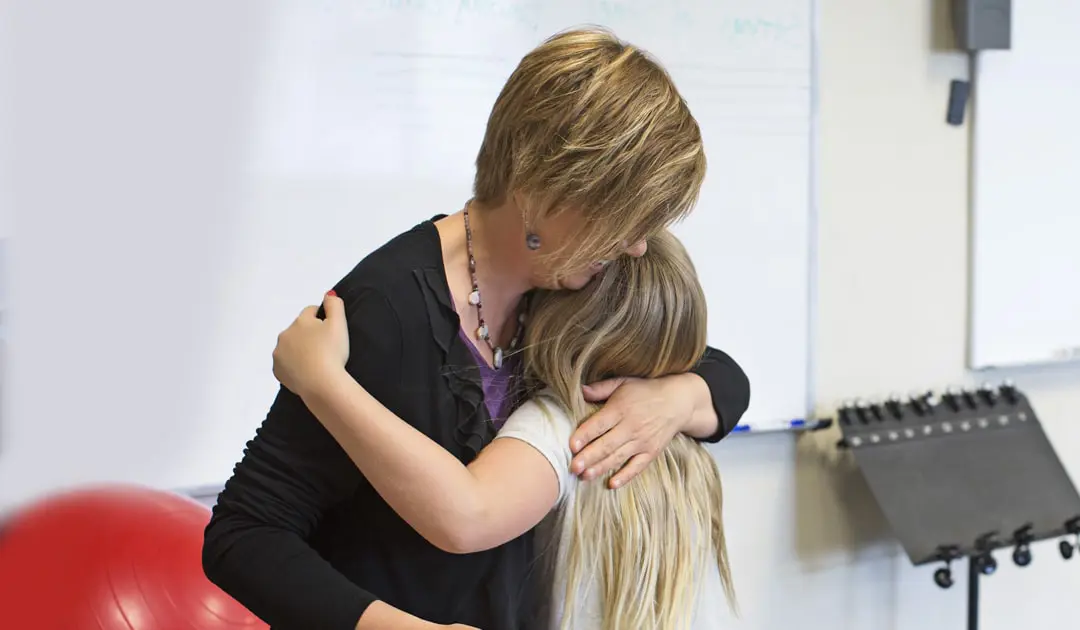Behavior is Communication: A Deeper Dive

I want to explore the meaning beneath the statement behavior is communication. It’s a catchphrase that has been ringing in educators’ ears for a while now, finding its way onto the occasional t-shirt, coffee mug, and even posters hanging in the teacher’s lounge. Cognitively we certainly all understand this. But do we truly feel what behavior is communication means as we interact with our students all day long?
A Lesson from Nellie.
Nellie is our rescue dog. Today she is a wonderful companion, but over her first 18 months of life we know Nellie experienced severe neglect and abuse.
As I walked Nellie one recent morning, I was reminded that many mammals—especially dogs—have communication systems that resemble ours at the emotional level. Put another way, they both embody lived experiences.
In Nellie’s case, past traumatic experiences live in her nervous system, and Nellie’s past becomes her present moment of communication. Anytime the doorbell rings, Nellie’s 45-pound body becomes rigid, her back hairs stand on end, and she begins growling and shaking. I think we can agree that her reaction is based on something that goes far deeper than behavior is communication. Nellie’s behavior is signaling profound fear. She does not look fearful; she looks scary!
Nellie is misunderstood, and her behavior is why she is misunderstood.
Past Experiences. Present Behaviors.
Humans also detect safety or danger through embodied past experiences. Those past experiences can bubble up and affect how we communicate and live in the present moment.
Tones and cadences of voices, gestures, and postures of humans can nonverbally create anxiety, dread or terror or signal safety in others. Early traumatic experiences can shift how we communicate with each other, and this is a two-way street as emotions are highly contagious. Anytime we are communicating thoughts and feelings, we carry into the conversation the states of our nervous systems. Whether we are communicating with a child, adolescent, or another adult, our attachment dynamics are present and observed. We communicate with one another in relational or detached attachment. Our behaviors are only the signals or indicators that provide clues to sensory or emotional states beneath the behaviors.
Yes, Behavior is Communication. But What’s Beneath the Behavior?
Attachment, when you peel the layers away, is the gravitational force that pulls us to one another so we can survive. Attachment is embedded in our nervous systems. When we only address the behaviors we observe in one another, we can liken this to placing a band-aid on an open wound in need of 30 stitches. If all behavior is indeed communication, then we need to address what lies beneath the behaviors, and our bodies often share the underbelly of our behaviors without thought or resistance.
If you want to know which way the wind is blowing, look at the sand. If we want to know how a child is feeling, look at her body.
I want to emphasize the body states and communication indicators of the adults who are receiving a variety of behaviors through embodied communication systems in the classroom.
The questions below will be helpful as we deeply reflect upon our nervous system states when confronted with dysregulated behaviors that may in fact be communicating pain-based behaviors. When we are intentional about exploring our own reactions (sensations, feelings, and thoughts) when dysregulated behaviors show up, we will meet our students in a state of regulation and our discipline practices will become relational, preventative, and brain-aligned.
- What is my behavior communicating to the student? What are my gestures, face, posture, and tone communicating?
- Have I checked in with my nervous system?
- Am I checking in with my authentic self? Authenticity is the state of being in touch with ourselves, so am I checking in with my gut feelings?
- Do certain students trigger me more than others?
- Are my responses to each student’s behavior the same?
- Which students do I redirect most often?
- What behaviors do they show?
- What behaviors do I expect to see?
- What emotion do I feel when certain students do not follow my directions?
- Which behaviors push my buttons most?
- What time in the day do I feel the most calm and happy with my students? (Silence, chatter, students listening to me speak, students speaking to each other)
- What time of day do I feel most dysregulated with my students?
- What is my definition of calm and connected students?
- Which students do I feel the closest to in my class?
- Why do I feel connected to them?
- Which students are my “favorites?” Why?
- Do I understand the cultural identity of my students? If not, what can I do to learn more?
- Do I attempt to make connections to my students’ culture and backgrounds in an authentic way?
- Do my students feel safe to be their authentic selves?
- Am I creating a community of inclusion and equitable access? (Everyone gets what they need- not the same thing for everyone)
- Do we have to make people feel bad to change their behavior?
Dr. Lori Desautels is an assistant professor in the College of Education at Butler University in Indianapolis, Indiana. Lori was also an assistant professor at Marian University in Indianapolis, where she founded the Educational Neuroscience Symposium, now sponsored by Butler University. Lori has created webinars for educators, clinicians, and administrators illustrating how educators and students alike must understand their neuroanatomy to regulate behavior and calm the brain. You can learn more about her work at Revelations In Education.
Schedule a Consultation
Learn how CPI’s training programs can benefit your organization.
Let's Connect